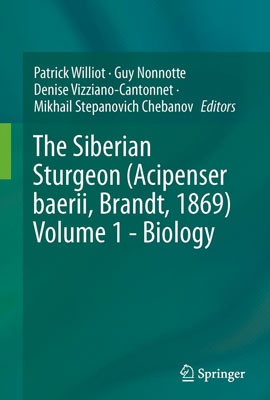
BOOKS | AUG 2018
The Siberian Sturgeon
(Acipenser baerii, Brandt, 1869)
Volume 1 – Biology
Editors: Williot, P., Nonnotte, G., Vizziano-Cantonnet, D., Chebanov, M. (Eds.)
Provides a comprehensive synthesis of the sturgeon’s biology, including: Biology and Ecology, Physiology of Reproduction, and Eco-physiology, i.e. adaptation to the environment
Shares detailed insights on unusual topics and/or updated syntheses, e.g. species-specificity, new insights on mineralization and ossification, genetic sex determination, transposable elements in gonads, early ontogeny, sensory capacity, nutrition, swimming, chemical neuroanatomy of the central nervous system, oogenesis with the unique simultaneous description by image and physiological phenomena, gonadal steroids, steroid profiles, physiological effects of environmental stress (hypoxia and exposition to ammonia particularly), as well as selected methods (aortic cannulation, respiration physiology)
Intended for fish biologists, specialists in comparative biology and/or evolutionary biology, sturgeon scientists, sturgeon farmers, and consultants in a variety of fields, e.g. in aquaculture, farming design, and water management.
The biology of the Siberian sturgeon, Acipenser baerii Brandt 1869, has become a very attractive subject of investigation for biologists since the 1980s. This volume 1 is part of a two-volume set devoted to the species, the second of which focuses on farming. The present volume is divided into three parts: Biology and ecology, Biology and physiology of reproduction, and Ecophysiology, i.e. adaptation to the environment.
The first part addresses a broad range of topics, such as: the ecology, including a new approach to species-specificity, a new insight on the mineralization of vertebral elements, two approaches to sex determination, transposable elements in the gonads, early ontogeny, olfaction and gustation, nutrition and swimming. The second part includes neurochemical and anatomical descriptions of the central nervous system and an updated version of the oogenesis, the characteristics of both sperm and spermatozoa, and a synthesis on gonadal steroids (synthesis, plasmatic levels and biological activities). In turn, the third part reveals how the physiology of the species changes depending on environmental factors such as oxygen, ammonia, and nitrite. Some fundamental consequences of ammonia are developed (sublethal and lethal levels, effects on gill epithelium and haematology, acid-base balance, on AA and adenyl nucleotides levels in plasma, brain and muscle tissue). In addition, the book includes two methodological chapters dealing with fish dorsal aortic cannulation and respiration physiology.


